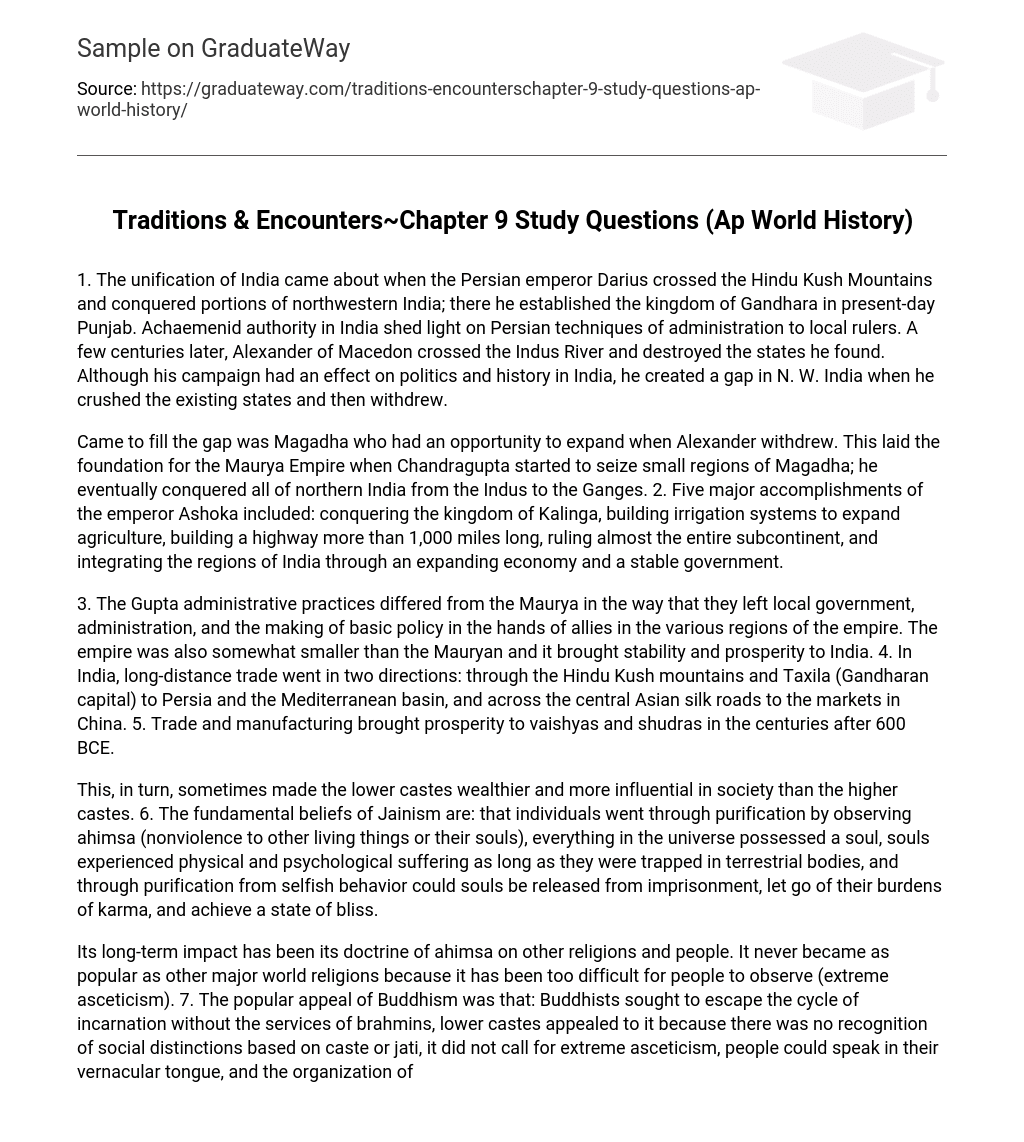1. The unification of India came about when the Persian emperor Darius crossed the Hindu Kush Mountains and conquered portions of northwestern India; there he established the kingdom of Gandhara in present-day Punjab. Achaemenid authority in India shed light on Persian techniques of administration to local rulers. A few centuries later, Alexander of Macedon crossed the Indus River and destroyed the states he found. Although his campaign had an effect on politics and history in India, he created a gap in N. W. India when he crushed the existing states and then withdrew.
Came to fill the gap was Magadha who had an opportunity to expand when Alexander withdrew. This laid the foundation for the Maurya Empire when Chandragupta started to seize small regions of Magadha; he eventually conquered all of northern India from the Indus to the Ganges. 2. Five major accomplishments of the emperor Ashoka included: conquering the kingdom of Kalinga, building irrigation systems to expand agriculture, building a highway more than 1,000 miles long, ruling almost the entire subcontinent, and integrating the regions of India through an expanding economy and a stable government.
3. The Gupta administrative practices differed from the Maurya in the way that they left local government, administration, and the making of basic policy in the hands of allies in the various regions of the empire. The empire was also somewhat smaller than the Mauryan and it brought stability and prosperity to India. 4. In India, long-distance trade went in two directions: through the Hindu Kush mountains and Taxila (Gandharan capital) to Persia and the Mediterranean basin, and across the central Asian silk roads to the markets in China. 5. Trade and manufacturing brought prosperity to vaishyas and shudras in the centuries after 600 BCE.
This, in turn, sometimes made the lower castes wealthier and more influential in society than the higher castes. 6. The fundamental beliefs of Jainism are: that individuals went through purification by observing ahimsa (nonviolence to other living things or their souls), everything in the universe possessed a soul, souls experienced physical and psychological suffering as long as they were trapped in terrestrial bodies, and through purification from selfish behavior could souls be released from imprisonment, let go of their burdens of karma, and achieve a state of bliss.
Its long-term impact has been its doctrine of ahimsa on other religions and people. It never became as popular as other major world religions because it has been too difficult for people to observe (extreme asceticism). 7. The popular appeal of Buddhism was that: Buddhists sought to escape the cycle of incarnation without the services of brahmins, lower castes appealed to it because there was no recognition of social distinctions based on caste or jati, it did not call for extreme asceticism, people could speak in their vernacular tongue, and the organization of the Buddhist movement.
It compares to Hinduism in the way that both wanted to escape the cycle of incarnation and the attainment of salvation/enlightenment. The two contrast in the way that the teachings of the Four Noble Truths and the Noble Eightfold Path make up Buddhist dharma, while in Hinduism, dharma (obedience to religious and moral laws), artha (prosperity), kama (pleasure), and moksha (salvation) are the four principal aims of life. 8.
Early Buddhism evolved into Mahayana Buddhism when three new Buddhist thoughts developed to reduce the obligations of believers, open new roads to salvation, and bring popularity to the faith. First, Buddhism attained a devotional focus when followers started to worship Buddha as a god. Theologians then developed the idea of boddhisatva (“an enlightened being”). Boddhisatvas were individuals who already reached spiritual perfection, but are delaying their entry into nirvana to help others who are still struggling.
Lastly, Buddhist monasteries started to accept gifts from wealthy patrons and regarded these acts of kindness as merits for salvation. These helped to open up new avenues for salvation for many people who called their faith the Mahayana (‘the greater vehicle”). It helped spread the religion and attract converts from wealthy classes. 9. Hinduism evolved in India during this period as it underwent an evolution of new ideas and widespread popular interest which helped it turn into a popular religion of salvation.
It drew inspiration from the Vedas and Upanishads and drew away from the old traditions of the brahmins. 10. Buddhism eventually lost popularity in India because Hinduism offered salvation to a large amount of people, attracted political support and patronage, and gained land grants from the Guptas who also supported an educational system that promoted Hindu values. Hinduism became a dominant religion and cultural tradition in India with the help of the Guptas and their successors.





